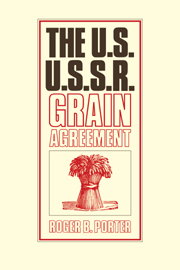Book contents
- Frontmatter
- Contents
- Foreword
- Preface
- List of acronyms used in the text
- 1 Introduction
- 2 U.S.–Soviet grain trade before 1974
- 3 The 1974 experience
- 4 The Russians return
- 5 First steps
- 6 A strategy emerges
- 7 Agreement to seek a long-term arrangement
- 8 Refining the details
- 9 Ebbing leverage: the waiting game
- 10 Evaluations
- 11 Reflections
- Epilogue
- Appendices
- Bibliography
- Index
8 - Refining the details
Published online by Cambridge University Press: 05 November 2011
- Frontmatter
- Contents
- Foreword
- Preface
- List of acronyms used in the text
- 1 Introduction
- 2 U.S.–Soviet grain trade before 1974
- 3 The 1974 experience
- 4 The Russians return
- 5 First steps
- 6 A strategy emerges
- 7 Agreement to seek a long-term arrangement
- 8 Refining the details
- 9 Ebbing leverage: the waiting game
- 10 Evaluations
- 11 Reflections
- Epilogue
- Appendices
- Bibliography
- Index
Summary
The September II crop report showed a further deterioration in the U.S. crop, supporting those who had urged caution on further sales. The Food Deputies Report reviewing the September crop report detailed evidence that the Soviets had reduced grain exports to Eastern Europe, causing greater demands on U.S. markets.
Throughout September and early October, the subcabinet-level EPB interagency machinery, relying heavily on the staffs at the Council of Economic Advisers, the Department of Agriculture, and the Central Intelligence Agency, provided detailed technical estimates of Soviet production and requirements and new forecasts of supply and demand for American grain. The reports were distributed to Executive Committee members and discussed either at the regular morning meetings of the Executive Committee or in special sessions, sometimes referred to as meetings of the Food Committee.
The Food Committee meetings were organized by Seidman and his staff under the umbrella of the EPB Executive Committee or in his capacity as staff coordinator of the EPB/NSC Food Committee. Seidman and his staff also coordinated preparation of the substantive analyses considered at the meetings, controled the attendance and timing of the meetings, and prepared the materials sent to the president to keep him informed on the matter. The meetings regularly included representatives from the EPB Executive Committee agencies – Treasury, CEA, OMB, CIEP, State, Labor, and Commerce – and representatives from the Department of Agriculture, the NSC, and occasionally the Office of the Special Representative for Trade Negotiations.
- Type
- Chapter
- Information
- The U.S.-U.S.S.R. Grain Agreement , pp. 71 - 80Publisher: Cambridge University PressPrint publication year: 1984



